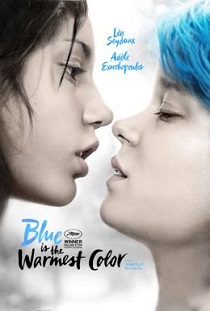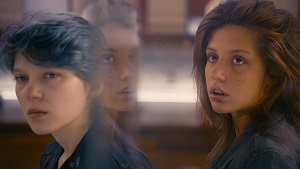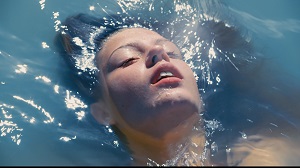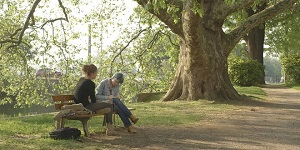 Blue is the Warmest Color, the nearly three-hour French character study of a lesbian relationship, is a remarkable film.
Blue is the Warmest Color, the nearly three-hour French character study of a lesbian relationship, is a remarkable film.
Part of what makes it so remarkable is its length. With a three-hour running time, one might expect director Abdellatif Kechiche to move quickly from scene to scene in an attempt to cram in as many moments as possible to give the movie a more complete picture.
Instead, the Tunisian-born Kechiche’s strategy is to pinpoint fewer key moments and give each scene time to breathe — making sure that above all else, they have the ring of truth. This goes not only for scenes that take place at school, at parties, or across the dinner table, but also for the sex scenes. No movie in recent memory has constructed bedroom moments that contain this much passion or explicitness — much less taken the time to show the evolution of lovemaking between two people.
The graphic sex scenes earned Blue is the Warmest Color an NC-17 rating, but it is the film’s raw depiction of infatuation, lust, and heartbreak that won it the Palm d’Or at Cannes this year when no less a mainstream American icon than Steven Spielberg headed up the jury.
 The French title of the movie is La Vie d’Adèle—Chapitres 1 et 2, which illuminates both its two-part structure and single-perspective point of view. A high-school student who is already deeply interested in affairs of the heart and philosophy in the classic literature she reads at school (some if it, like Antigone, is a little too on-the-nose), Adèle (Adèle Exarchopoulos) doesn’t quite fit in with the other girls her age. The first 90 minutes of the movie is her coming-of-age story and its shot with an intimacy that is unsettling at first.
The French title of the movie is La Vie d’Adèle—Chapitres 1 et 2, which illuminates both its two-part structure and single-perspective point of view. A high-school student who is already deeply interested in affairs of the heart and philosophy in the classic literature she reads at school (some if it, like Antigone, is a little too on-the-nose), Adèle (Adèle Exarchopoulos) doesn’t quite fit in with the other girls her age. The first 90 minutes of the movie is her coming-of-age story and its shot with an intimacy that is unsettling at first.
Gradually, we get used to being so close to Adèle, figuratively and literally — through the nonstop closeups of her face. When she sees confident, blue-haired young artist Emma (Léa Seydoux) walk by one day with her girlfriend, it’s like she’s been hit by a truck. The attraction is immediate. A friend takes Adèle to a gay bar, which she only goes to for one reason. She sees Emma there, they talk, and her life changes overnight.
 This is what unbridled passion looks like. Every scene between Adèle and Emma is charged. The first blinding rush of new love is everything — especially to Adèle — and the actresses portray it all with such natural tendencies that it is counter-intuitive to think that Kechiche arrived at these scenes by forcing his actresses through take after take after grueling take, as they have accused him of. The film also departs substantially from the graphic novel by Julie Maroh which inspired it.
This is what unbridled passion looks like. Every scene between Adèle and Emma is charged. The first blinding rush of new love is everything — especially to Adèle — and the actresses portray it all with such natural tendencies that it is counter-intuitive to think that Kechiche arrived at these scenes by forcing his actresses through take after take after grueling take, as they have accused him of. The film also departs substantially from the graphic novel by Julie Maroh which inspired it.
Chapter two is a study in contrasts. Shot with the same immediacy and focus on Adèle (but a lack of internal monologue), its tone is decidedly different. Because of the closeness we felt in chapter one, the relationship as it has evolved is tougher to swallow. In one scene that can stand in for the entirety of the second act, Adèle is isolated and alone, despite having reached her goal of becoming a teacher. She stands among children who are running about and playing feverishly, competing for her attention, yet she’s somewhere else, staring into nothing.
 To achieve the urgency and excitement of Blue is the Warmest Color, 800 hours of footage was filmed over five months. Exarchopoulos and Seydoux were encouraged to improvise and live fully in each moment, and the result is electric. Two fearless performances and three hours later, the movie succeeds in bringing such emotional complexity to life that its easy to relate to for anyone who has been in love.
To achieve the urgency and excitement of Blue is the Warmest Color, 800 hours of footage was filmed over five months. Exarchopoulos and Seydoux were encouraged to improvise and live fully in each moment, and the result is electric. Two fearless performances and three hours later, the movie succeeds in bringing such emotional complexity to life that its easy to relate to for anyone who has been in love.
The film’s notorious sex scenes are just a small part of the larger picture, because the movie asks a lot of timeless questions about love and devotion: How lopsided can love be? Is all-encompassing love “good for you”? How does it limit you? What will you give up for love? That is why Blue is the Warmest Color will have enduring appeal and hopefully move beyond the reason it is currently making headlines.








Comments on this entry are closed.